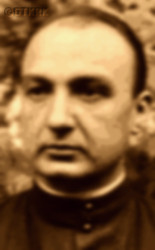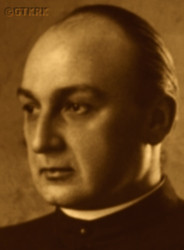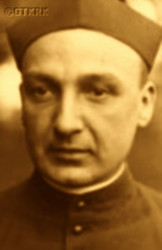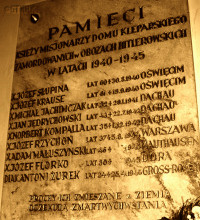Roman Catholic
St Sigismund parish
05-507 Słomczyn
85 Wiślana Str.
Konstancin deanery
Warsaw archdiocese, Poland
full list:
displayClick to display full list

searchClick to search full list by categories
wyświetlKliknij by wyświetlić pełną listę po polsku

szukajKliknij by przeszukać listę wg kategorii po polsku

Martyrology of the clergy — Poland
XX century (1914 – 1989)
personal data
religious status
Servant of God
surname
MAŁUSZYŃSKI
forename(s)
Adam
function
religious cleric
creed
Latin (Roman Catholic) Church RCmore on
en.wikipedia.org
[access: 2014.09.21]
congregation
Congregation of the Mission CMmore on
en.wikipedia.org
[access: 2013.05.19]
(i.e. Vincentians, Lazarists)
honorary titles
„Cross of Independence”more on
„Cross of Independence”
(19.12.1933)
Gold „Cross of Merit”more on
Gold „Cross of Merit”
(15.03.1939)
date and place
of death
31.01.1945

KL Mittelbau‐Doraconcentration camp
today: n. Nordhausen, Nordhausen dist., Thuringia state, Germany
more on
en.wikipedia.org
[access: 2022.01.09]
details of death
From 20.12.1914, during World War I, a soldier of the Polish Legions (then part of Austro–Hungarian imperial army) — 3rd company of the 3rd Battalion of the 1st Infantry Regiment.
On 18.02.1915 a lancer in the 2nd platoon of the 3rd squadron of the 1st Uhlan Regiment (during a positional war with Russians along Nida river in 1915 prob. was stationed in Kawęczyn).
After German and Russian invasion of Poland in 09.1939 and start of the World War II, after start of German occupation, arrested by the Germans on 20.11.1943 for refusing to minister to a funeral of Louis Nowak, the guard of St Michael prison — where ministered — religiously indifferent, known to maltreat prisoners and conduct execution of Polish prisoners, who was murdered by a relative.
In retaliation Germans, apart from arresting him, executed 10 other Poles.
Jailed in Montelupich Str. prison in Kraków.
On 14.12.1943 transported to KL Auschwitz concentration camp.
From there on 24.06.1944 transported to KL Buchenwald concentration camp and finally on 28.10.1944‐01.11.1944 to KL Mittelbau‐Dora concentration camp where perished during camp evacuation.
prisoner camp's numbers
62444Click to display source page (KL BuchenwaldClick to display the description), 168051Click to display source page (KL AuschwitzClick to display the description)
cause of death
extermination
perpetrators
Germans
sites and events
KL Mittelbau‐DoraClick to display the description, KL BuchenwaldClick to display the description, KL AuschwitzClick to display the description, Regierungsbezirk KattowitzClick to display the description, Cracow (Montelupich)Click to display the description, GeneralgouvernementClick to display the description, Ribbentrop‐MolotovClick to display the description, Pius XI's encyclicalsClick to display the description
date and place
of birth
10.12.1898

Sykhivtoday: district in Lviv, Lviv urban hrom., Lviv rai., Lviv obl., Ukraine
more on
uk.wikipedia.org
[access: 2020.07.31]
alt. dates and places
of birth
Sytykhivtoday: Lviv urban hrom., Lviv rai., Lviv obl., Ukraine
more on
en.wikipedia.org
[access: 2023.03.02]
parents
MAŁUSZYŃSKI Julius
🞲 ?, ? — 🕆 ?, ?

GRABOWSKA Janet
🞲 ?, ? — 🕆 ?, ?
presbyter (holy orders)
ordination
1936

positions held
c. 1939 – 1943
priest — Krakówtoday: Kraków city pov., Lesser Poland voiv., Poland
more on
en.wikipedia.org
[access: 2021.06.07] ⋄ Vincentians CM — chaplain of the St Michael prison
1936 – c. 1939
priest — Viennatoday: Vienna state, Austria
more on
en.wikipedia.org
[access: 2020.07.31] ⋄ Congregation's house (at 7 Kaiserstrasse), Vincentians CM
from 1930
friar — Vincentians CM
others related
in death
GUZIKClick to display biography Stanislav, JĘDRAClick to display biography Martin, ŁUKOWIAKClick to display biography Anthony, MICHAŁKOWSKIClick to display biography John Chrysostom, PANKOWSKIClick to display biography Marian, WOJCIECHOWSKIClick to display biography Steven
sites and events
descriptions
KL Mittelbau‐Dora: German Germ. Konzentrationslager (Eng. concentration camp) KL, operational from 08.1943 till 11.04.1945 when American troops entered the camp. Set up to provide the slave workforce for an underground military factory „Mittelwerk” — in tunnels of Kohnstein mountain n. Nordhausen town V‐1 and V‐2 rockets were manufactured. Initially functioned as a sub‐camp of KL Buchenwald concentration camp (till summer 1944). Approx. 20,000 prisoner perished (large part of them were brought there at the end of 1944, in „death marches”, from KL Auschwitz), among whom 10,000 during camp evacuation (which also took form of „death marches”) — in 04.1945, right before liberation. Also c. 1,200 prisoners perished during bombardments by the Allied forces. (more on: en.wikipedia.orgClick to attempt to display webpage
[access: 2022.01.09])
KL Buchenwald: In German Germ. Konzentrationslager (Eng. concentration camp) KL Buchenwald concentration camp, founded in 1937 and operational till 1945, Germans held c. 238,380 prisoners and murdered approx. 56,000 of them, among them thousands of Poles. Prisoners were victims of pseudo‐scientific experiments, conducted among others by Behring‐Werke from Marburg and Robert Koch Institute from Berlin companies. They slaved for Gustloff in Weimar and Fritz‐Sauckel companies manufacturing armaments. To support Erla‐Maschinenwerk GmbH in Leipzig, Junkers in Schönebeck (airplanes) and Rautal in Wernigerode Germans organized special sub‐camps. In 1945 there were more than 100 such sub‐camps. Dora concentration camp was initially one of them, as well as KL Ravensbrück sub‐camps (from 08.1944). On 08.04.1945 Polish prisoner, Mr Guido Damazyn, used clandestinely constructed short wave transmitter to sent, together with a Russian prisoner, a short message begging for help. It was received and he got a reply: „KZ Bu. Hold out. Rushing to your aid. Staff of Third Army” (American). Three days later the camp was liberated. (more on: www.buchenwald.deClick to attempt to display webpage
[access: 2013.08.10], en.wikipedia.orgClick to attempt to display webpage
[access: 2013.08.10])
KL Auschwitz: German Germ. Konzentrationslager (Eng. concentration camp) KL and Germ. Vernichtungslager (Eng. extermination camp) VL Auschwitz was set up by Germans around 27.01.1940 n. Oświęcim, on the German territory (initially in Germ. Provinz Schlesien — Silesia Province; and from 1941 Germ. Provinz Oberschlesien — Upper Silesia Province). Initially mainly Poles were interned. From 1942 it became the centre for holocaust of European Jews. Part of the KL Auschwitz concentration camps’ complex was Germ. Vernichtungslager (Eng. extermination camp) VL Auschwitz II Birkenau, located not far away from the main camp. There Germans murdered likely in excess of million people, mainly Jews, in gas chambers. In KL Auschwitz alone, the Germans murdered c. 30,000 prisoners by lethal injection. Until 1941, people were killed by intravenous injections of concentrated hydrogen peroxide, ether, hydrogen peroxide, or gasoline. Later, an intracardiac injection was used — with a needle about 10 cm long — of 10‐15 ml of a 30% solution of phenol C6H5OH (acquired from the German concern IG Farben, or more precisely from its subsidiary Bayer, and still used by Bayer AG, among others, for the production of aspirin), which killed within 15 seconds. Altogether In excess of 400 priests and religious went through the KL Auschwitz, c. 40% of which were murdered (mainly Poles). (more on: en.auschwitz.org.plClick to attempt to display webpage
[access: 2012.11.23], www.meczennicy.pelplin.plClick to attempt to display webpage
[access: 2013.07.06])
Regierungsbezirk Kattowitz: After the Polish defeat in the 09.1939 campaign, which was the result of the Ribbentrop‐Molotov Pact and constituted the first stage of World War II, and the beginning of German occupation in part of Poland (in the other, eastern part of Poland, the Russian occupation began), the Germans divided the occupied Polish territory into five main regions (and a few smaller). The largest one was transformed into Germ. Generalgouvernement (Eng. General Governorate), intended exclusively for Poles and Jews and constituting part of the so‐called Germ. Großdeutschland (Eng. Greater Germany). From two separate new provinces were created. The two remaining were incorporated into existing German provinces. One of those was Polish Upper Silesia, which on 08.09.1939, by decree of the German leader Adolf Hitler (formally came into force on 26.10.1939), was incorporated into Germany as the Germ. Regierungsbezirk Kattowitz (Eng. Katowice Regency) and became part of the Germ. Provinz Schlesien (Eng. Province of Silesia) based in Wrocław. On 01.04.1940, the Germ. Regierungsbezirk Kattowitz was enlarged by several pre‐war German counties, and on 18.01.1941, a new German province was created, the Germ. Provinz Oberschlesien (Eng. Province of Upper Silesia), which, apart from the Germ. Regierungsbezirk Kattowitz, also included the Opole region. From 26.10.1939, when the regency was established, the law of the German state was in force there, the same as in Berlin. The main axis of the policy of the new regency, the territory of which the Germans recognized as the Germ. „Ursprünglich Deutsche” (Eng. „natively German”), despite the fact only 6% of its pre–war Polish part were Germans, was Germ. „Entpolonisierung” (Eng. „Depolonisation”), i.e. forced Germanization. The main mechanism was the introduction of the Germ. Deutsche Volksliste DVL, a German nationality list that was supposed to specify the national affiliation of the inhabitants of the region. The largest group marked in the compulsory registrations was Group 3, people who identified themselves as „Silesians” (in 1943 about 41%), and people remaining outside the DVL (about 36%). The latter group was intended to be deported to the Germ. Generalgouvernement (which did not happen en masse because German industry needed slave labor). Group 3, considered by the Germans as capable of Germanization, was subject to certain legal restrictions, and was subject to, among others, to conscription into the German Wehrmacht army. Children could only learn in German. A policy of terror was pursued against the Polish population. There was a special police court, controlled by the Germ. Geheime Staatspolizei (Eng. Secret State Police), i.e. the Gestapo, before which c. 4,000‐5,000 people were detained. For the years 1942‐1945 over 2,000 of them were verified, of which 1,890 were sentenced to death, including 286 in public executions. Thousands of people were murdered during the so‐called «Intelligenzaktion Schlesien», including 300‐650 Polish teachers and c. 61 Polish Catholic priests. The regency hosted a German concentration and extermination camp KL Auschwitz, where the Germans imprisoned c. 1,100,000 Jews (murdering c.1,000,000, i.e. c. 90% of them) and c. 140,000 Poles (murdering c. 70,000, i.e. c. 50% of them). After the end of hostilities of World War II, the overseer of this province, the Germ. Reichsstatthalter (Eng. Reich Governor) and the Germ. Gauleiter (Eng. district head) of the German National Socialist Party, Fritz Brecht, committed suicide. (more on: en.wikipedia.orgClick to attempt to display webpage
[access: 2024.06.24])
Cracow (Montelupich): Cracow penal prison, during occupation run by the Germans — from 28.02.1941 by Germ. Geheime Staatspolizei (Eng. Secret State Police, known as Gestapo. In 1940‐1944 Germans jailed there approx. 50,000 prisoners, mainly Poles and Jews. Some of them were transported to KL Auschwitz concentration camp, some were executed. After cease in war effort the prison was used by UB — a Polish unit of Russian NKVD — as a prison for Polish independence resistance fighters, some of which were subsequently sent to prisons and slave labour camps in Russia. (more on: en.wikipedia.orgClick to attempt to display webpage
[access: 2014.10.31])
Generalgouvernement: After the Polish defeat in the 09.1939 campaign, which was the result of the Ribbentrop‐Molotov Pact and constituted the first stage of World War II, and the beginning of German occupation in part of Poland (in the other, eastern part of Poland, the Russian occupation began), the Germans divided the occupied Polish territory into five main regions. In two of them new German provinces were created, two other were incorporated into other provinces. However, the fifth part was treated separately, and in a political sense it was supposed to recreate the German idea from 1915 (during World War I, after the defeat of the Russians in the Battle of Gorlice in 05.1915) of creating a Polish enclave within Germany. Illegal in the sense of international law, i.e. Hague Convention, and public law, managed by the Germans according to separate laws — especially established for the Polish Germ. Untermenschen (Eng. subhumans) — till the Russian offensive in 1945 it constituted part of the Germ. Großdeutschland (Eng. Greater Germany). Till 31.07.1940 formally called Germ. Generalgouvernement für die besetzten polnischen Gebiete (Eng. General Government for the occupied Polish lands) — later simply Germ. Generalgouvernement (Eng. General Governorate), as in the years 1915‐1918. From 07.1941, i.e. after the German attack on 22.06.1941 against the erstwhile ally, the Russians, it also included the Galicia district, i.e. the Polish pre‐war south‐eastern voivodeships. A special criminal law was enacted and applied to Poles and Jews, allowing for the arbitrary administration of the death penalty regardless of the age of the „perpetrator”, and sanctioning the use of collective responsibility. After the end of the military conflict of the World War UU, the government of the Germ. Generalgouvernement was recognized as a criminal organization, and its leader, governor Hans Frank, guilty of war crimes and crimes against humanity and executed. (more on: en.wikipedia.orgClick to attempt to display webpage
[access: 2024.12.13])
Ribbentrop‐Molotov: Genocidal Russian‐German alliance pact between Russian leader Joseph Stalin and German leader Adolf Hitler signed on 23.08.1939 in Moscow by respective foreign ministers, Mr. Vyacheslav Molotov for Russia and Joachim von Ribbentrop for Germany. The pact sanctioned and was the direct cause of joint Russian and German invasion of Poland and the outbreak of the World War II in 09.1939. In a political sense, the pact was an attempt to restore the status quo ante before 1914, with one exception, namely the „commercial” exchange of the so‐called „Kingdom of Poland”, which in 1914 was part of the Russian Empire, fore Eastern Galicia (today's western Ukraine), in 1914 belonging to the Austro‐Hungarian Empire. Galicia, including Lviv, was to be taken over by the Russians, the „Kingdom of Poland” — under the name of the General Governorate — Germany. The resultant „war was one of the greatest calamities and dramas of humanity in history, for two atheistic and anti‐Christian ideologies — national and international socialism — rejected God and His fifth Decalogue commandment: Thou shall not kill!” (Abp Stanislav Gądecki, 01.09.2019). The decisions taken — backed up by the betrayal of the formal allies of Poland, France and Germany, which on 12.09.1939, at a joint conference in Abbeville, decided not to provide aid to attacked Poland and not to take military action against Germany (a clear breach of treaty obligations with Poland) — were on 28.09.1939 slightly altered and made more precise when a treaty on „German‐Russian boundaries and friendship” was agreed by the same murderous signatories. One of its findings was establishment of spheres of influence in Central and Eastern Europe and in consequence IV partition of Poland. In one of its secret annexes agreed, that: „the Signatories will not tolerate on its respective territories any Polish propaganda that affects the territory of the other Side. On their respective territories they will suppress all such propaganda and inform each other of the measures taken to accomplish it”. The agreements resulted in a series of meeting between two genocidal organization representing both sides — German Gestapo and Russian NKVD when coordination of efforts to exterminate Polish intelligentsia and Polish leading classes (in Germany called «Intelligenzaktion», in Russia took the form of Katyń massacres) where discussed. Resulted in deaths of hundreds of thousands of Polish intelligentsia, including thousands of priests presented here, and tens of millions of ordinary people,. The results of this Russian‐German pact lasted till 1989 and are still in evidence even today. (more on: en.wikipedia.orgClick to attempt to display webpage
[access: 2015.09.30])
Pius XI's encyclicals: Facing the creation of two totalitarian systems in Europe, which seemed to compete with each other, though there were more similarities than contradictions between them, Pope Pius XI issued in 03.1937 (within 5 days) two encyclicals. In the „Mit brennender Sorge” (Eng. „With Burning Concern”) published on 14.03.1938, condemned the national socialism prevailing in Germany. The Pope wrote: „Whoever, following the old Germanic‐pre‐Christian beliefs, puts various impersonal fate in the place of a personal God, denies the wisdom of God and Providence […], whoever exalts earthly values: race or nation, or state, or state system, representatives of state power or other fundamental values of human society, […] and makes them the highest standard of all values, including religious ones, and idolizes them, this one […] is far from true faith in God and from a worldview corresponding to such faith”. On 19.03.1937, published „Divini Redemptoris” (Eng. „Divine Redeemer”), in which criticized Russian communism, dialectical materialism and the class struggle theory. The Pope wrote: „Communism deprives man of freedom, and therefore the spiritual basis of all life norms. It deprives the human person of all his dignity and any moral support with which he could resist the onslaught of blind passions […] This is the new gospel that Bolshevik and godless communism preaches as a message of salvation and redemption of humanity”… Pius XI demanded that the established human law be subjected to the natural law of God , recommended the implementation of the ideal of a Christian state and society, and called on Catholics to resist. Two years later, National Socialist Germany and Communist Russia came together and started World War II. (more on: www.vatican.vaClick to attempt to display webpage
[access: 2023.05.28], www.vatican.vaClick to attempt to display webpage
[access: 2023.05.28])
sources
personal:
www.meczennicy.pelplin.plClick to attempt to display webpage
[access: 2012.11.23], pl.wikipedia.orgClick to attempt to display webpage
[access: 2013.02.09], www.hagiographycircle.comClick to attempt to display webpage
[access: 2012.11.23]
bibliographical:
„Catalogue des Maisons et du Personnel de la Congregation de la MissionClick to display source page”
original images:
www.salon24.plClick to attempt to display webpage
[access: 2017.11.07], misjonarze.plClick to attempt to display webpage
[access: 2017.11.07], krakowianie1939-56.mhk.plClick to attempt to display webpage
[access: 2017.11.07], www.miejscapamiecinarodowej.plClick to attempt to display webpage
[access: 2015.04.18]
LETTER to CUSTODIAN/ADMINISTRATOR
If you have an Email client on your communicator/computer — such as Mozilla Thunderbird, Windows Mail or Microsoft Outlook, described at WikipediaPatrz:
en.wikipedia.org, among others — try the link below, please:
LETTER to CUSTODIAN/ADMINISTRATORClick and try to call your own Email client
If however you do not run such a client or the above link is not active please send an email to the Custodian/Administrator using your account — in your customary email/correspondence engine — at the following address:

giving the following as the subject:
MARTYROLOGY: MAŁUSZYŃSKI Adam
To return to the biography press below:
 Click to return to biography
Click to return to biography











